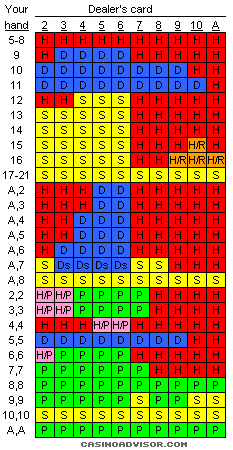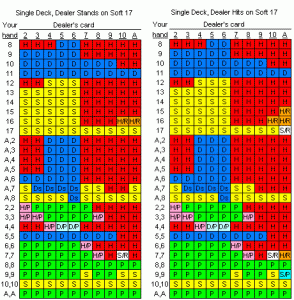If you go over 21 you bust, and the dealer wins regardless of the dealer's hand. If you are dealt 21 from the start (Ace & 10), you got a blackjack. Blackjack usually means you win 1.5 the amount of your bet. Depends on the casino. Dealer will hit until his/her cards total 17 or higher.
On This Page
Introduction
To use the basic strategy, look up your hand along the left vertical edge and the dealer's up card along the top. In both cases an A stands for ace. From top to bottom are the hard totals, soft totals, and splittable hands. There are two charts depending on whether the dealer hits or stands on soft 17.
Other basic strategy rules.
- Never take insurance or 'even money.'
- If there is no row for splitting (fives and tens), then look up your hand as a hard total (10 or 20).
- If you can't split because of a limit on re-splitting, then look up your hand as a hard total.
If you play a mixture of six-deck games, some where the dealer hits a soft 17, and some where he stands, and you only wish to memorize one strategy, I would recommend you memorize the one where the dealer stands on soft 17. The cost in errors due to playing the wrong strategy is 2.3 times higher playing a stand on soft 17 game, with the hit on 17 strategy, than vise versa.
Basic Strategy in Text
For the benefit of my blind readers, here is the above strategy in text form, when the dealer stands on soft 17 and surrender is allowed. To use the strategy, start at the top, and follow the first rule that applies.
Surrender
- Surrender hard 16 (but not a pair of 8s) vs. dealer 9, 10, or A, and hard 15 vs. dealer 10.

Split
- Always split aces and 8s.
- Never split 5s and 10s.
- Split 2s and 3s against a dealer 4-7, and against a 2 or 3 if DAS is allowed.
- Split 4s only if DAS is allowed and the dealer shows a 5 or 6.
- Split 6s against a dealer 3-6, and against a 2 if DAS is allowed.
- Split 7s against a dealer 2-7.
- Split 9s against a dealer 2-6 or 8-9.
Blackjack Dealer Hit Soft 17
Double
- Double hard 9 vs. dealer 3-6.
- Double hard 10 except against a dealer 10 or A.
- Double hard 11 except against a dealer A.
- Double soft 13 or 14 vs. dealer 5-6.
- Double soft 15 or 16 vs. dealer 4-6.
- Double soft 17 or 18 vs. dealer 3-6.
Blackjack Basic Strategy Chart Dealer Stands On 17

Hit or Stand
- Always hit hard 11 or less.
- Stand on hard 12 against a dealer 4-6, otherwise hit.
- Stand on hard 13-16 against a dealer 2-6, otherwise hit.
- Always stand on hard 17 or more.
- Always hit soft 17 or less.
- Stand on soft 18 except hit against a dealer 9, 10, or A.
- Always stand on soft 19 or more.
As I've said many times, the above strategy will be fine under any set of rules. However, for you perfectionists out there, here are the modifications to make if the dealer hits a soft 17.

- Surrender 15, a pair of 8s, and 17 vs. dealer A.
- Double 11 vs. dealer A.
- Double soft 18 vs. dealer 2.
- Double soft 19 vs. dealer 6.
My thanks to Kelly for putting together the above text strategy.
I like to assume that anyone reading one of my posts is starting at zero. I’m not doing exactly that here, because I’m not explaining in detail all the rules of casino blackjack.
But I do want to draw the distinction between hard hands and soft hands.
Blackjack is a simple comparing game where the player and dealer each start with a two-card hand. The one with the higher total points for their hand wins the bet, but only if they keep theirtotal to 21 or below. A total of 22 or higher is an automatic loss.
The cards have points based on their rank. The numbered cards have the same number of points as their numbers: 2, 3, 4, 5, 6, 7, 8, 9, and 10. The face cards (jack, queen, and king) are alsoworth 10 points each.
The only exception is the ace. No one would blame you for thinking that an ace is worth 1 point. It is, in fact, in many situations, worth a single point.
But it’s also worth 11 points.
Blackjack Dealer Tips
When you have a hand with no aces in it, you have a hard total. This means that the total is what the total is.
For example, if you have a jack and a 3, you have a hard total of 13. There’s no wiggle room there. That’s the total.
But if you have an ace and a 3, you have a soft total. That’s because the ace counts as 11, but if you get a card that would otherwise give you a total of 22, you can count it as a 1 instead.
With an ace and a 3, you have a soft 14. If you hit that hand and get a 10, you have a hard 14. (Any hand where the ace must be considered 1 point to avoid busting is also considered a hardhand.)
The strategy for a player with a soft hand as opposed to a hard hand is significantly different. Since you have that added layer of protection from busting, the right move is often to play a softtotal more aggressively.
But when we talk about a soft 17 “rule” in blackjack, we’re talking about how the dealer plays his hand.